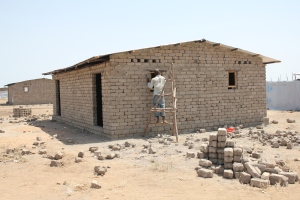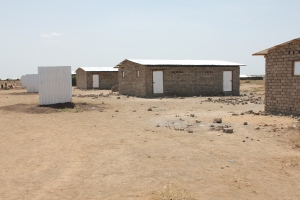In the fall of 2012, the UN Refugee Agency, UNHCR, started constructing permanent houses for refugees in Kakuma 3 settlement section mostly inhabited by new arrivals.
The new endeavor was meant to replace the temporary plastic tents that are stamped all over with ‘UNHCR,’ with a more conducive shelter constructed for refugees in this camp who are in transit. This was designed to accommodate new arrivals who are relocated from Dadaab camps.
According to an anonymous camp official, “the refugees who are relocated from Dadaab are only those who are eligible for resettlement to the United States.” Hence the new settlement section was referred to as the “Dadaab transit area.” The first and second groups of relocation took place in October and November 2012, while the third and the fourth relocation was in April 2013 and more relocation is expected by this August.
The relocation process was carried out by UNHCR with the assistance of the International Organization for Migration (IOM) because the US Immigration and Citizenship Services (USICS) staff in charge of resettlement feared insecurity at Dadaab following attacks, bombings and kidnappings of humanitarian aid workers, and hoped to conduct refugee resettlement services more conveniently at Kakuma Camp. While the set budget of 15 Million Kenyan shillings was designed to build four mail blocks at the Dadaab transit area in Kakuma 3, the allocated funds ran out before completing the set construction.

Members of the relocated new arrivals had different opinions to express, some had experienced violent attacks and insecurity prior to moving to Kakuma. “I was in a refugee camp for the last 20 years, while about 20% arrived later,” Fara Ibrahim – overall leader of the transit group – told Kanere. “While in Dadaab, a person can be killed in the market without finding the killers.” Fara concluded that Kakuma is safer compared to Dadaab complex.
The house seems to provide a more conducive atmosphere during the heat of the day than in the evening, however, cases of rape and theft are not rampant while the house can be better secured to the harsh weather condition of the desert. “We’ve the problems of hot plastic tents solved, I am promised resettlement and that’s why I am here,” said Halima at Kakuma 3 Zone 4.
Yet this development has sparked mixed feelings among the camp residents. The longstanding residents feel that they deserve better housing as opposed to new arrivals, due to having suffered poor living conditions for decades. Meanwhile others have negative perceptions of permanent housing, referring to it as encouragement of camp existence.

“I started living in this camp from 1997 under plastic tents; we don’t want to live for another 16 years again. What is the meaning of permanent shelters in 2013?” Aziza Zenawi said in an interview.
It’s not yet clear if the same initiative will be made available to older refugees most of whom have been warehoused since the early establishment of Kakuma Camp in 1991/2. “every year we seek house repairs to UNHCR, plastic tents, mud bricks don’t last for long, are we entitled to such houses?” A Sudanese shelter committee member.
However, despite the fact that permanent house are meant for refugees from Dadaab on transit, many of the older camp residents expressed worries that the new planned project might increases the chances of continued refugee warehousing.
